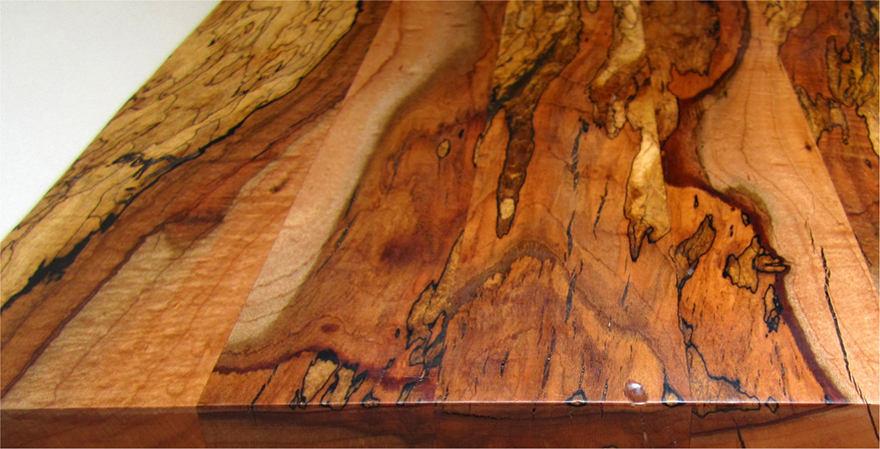An Introduction To Wood Species, Part 4: Maple

This Wood Species series of entries comes to us from guest writer Rob Wilkey, an Atlanta-based woodworker and industrial designer whose expertise is in small home goods, furniture, and large installations.
Over the next few articles, we'll be analyzing a number of common North American wood species. This week's featured species:

Maple lumber is sold under two distinct names: Soft Maple, which is harvested from a number of different species and has a Janka hardness of 700 to 900lbf; and Hard Maple, which comes from the Sugar Maple tree and has a much higher Janka hardness at 1450lbf. Hard Maple is the maple of choice for most woodworkers due to its density and structural stability, although the softer maples make a fine substitute in less demanding applications. Soft Maple is also cheaper, partly due to the fact that the softer species tend to grow faster, but also because many of the harvestable Sugar Maples are reserved for the production maple syrup.

Maple is a pale cream color when first cut, but will darken to light yellow or pale reddish brown with exposure to sunlight. Maple is diffuse-porous with small pores, and sands to a smooth, even surface. It is easy to cut and shape, but can be prone to tearout due to its occasionally interlocked grain pattern. Despite its density, even Hard Maple is susceptible to decay and suffers from a fair amount of seasonal movement, especially when left unfinished. Maple lumber should be joined securely and finished thoroughly to prevent any shifting with changes in temperature and humidity. The various species of maple are known to exhibit a wide range of figured grain patterns and are also prone to spalting. Spalted and figured pieces of maple are usually more expensive than plain boards, but their striking visual effects can make a project very unique and eye-catching.

Hard Maple is also desired for its properties as a tonewood—a type of wood that resonates sound particularly well. Many guitars, violins, basses, and other stringed instruments are constructed with maple necks and bodies. Slabs that feature continuous 'flame' figure are often selected for the back or front of these instruments for the unique chatoyant effect it creates, as seen on the electric guitar below.

The dense wood of the Sugar Maple is used in a myriad of applications, including cabinetry, flooring, furniture, cutting boards, baseball bats and even recurve bows. Its abundance, low price, and favorable working characteristics make it one of the most important commercial lumbers in North America. Maple also glues and finishes well, but can cause stains and dyes to absorb unevenly. Maple also burns easily when exposed to high-speed tools, so be careful around routers, saws, and power sanders. To get the best appearance, I'd recommend finish sanding maple by hand, and applying several coats of finish to pull out the reflective grain of the wood. Maple may be common, but it can look uncommonly beautiful when treated correctly.

Next week, we'll learn about the wood of the walnut tree, a lumber as chocolatey as the brownies that walnuts often ruin.
Material Matters: Wood
Species:
» An Introduction to Wood Species, Part 1: Properties & Terminology
» An Introduction to Wood Species, Part 2: Pine
» An Introduction to Wood Species, Part 3: Oak
» An Introduction to Wood Species, Part 4: Maple
» An Introduction to Wood Species, Part 5: Walnut
» An Introduction to Wood Species, Part 6: Cherry
» An Introduction To Wood Species, Part 7: Mahogany
» An Introduction To Wood Species, Part 8: Rosewood
» An Introduction To Wood Species, Part 9: Ebony
» An Introduction To Wood Species, Part 10: Teak
How Boards are Made:
» How Logs Are Turned Into Boards, Part 1: Plainsawn
» How Logs Are Turned Into Boards, Part 2: Quartersawn
» How Logs Are Turned Into Boards, Part 3: Riftsawn
Wood Movement:
» Wood Movement: Why Does Wood Move?
» Controlling Wood Movement: The Drying Process
» Dealing with Wood Movement: Design and Understanding
-
oFavorite This
-
Q3Comment
K
{Welcome
Create a Core77 Account
Already have an account? Sign In
By creating a Core77 account you confirm that you accept the Terms of Use
K
Reset Password
Please enter your email and we will send an email to reset your password.




Comments
Ha! I missed that the first time, agreed.
Also, I would like to add that, within tone woods, the high wood density of Maple resonates the high register especially well. This makes maple an excellent addition to the somewhat darker sounding but excellent tone wood mahogany, which most wooden instruments consist of. This is also why you will rarely see a instrument purely build from maple.
There are some exceptions of course, although these instruments will likely be so heavy that it will be uncomfortable to use over a longer period of time.